Wine flights! Cheese plates! Decadent desserts! It’s Eat What You Want Day, so stuff your face full of your favorite food and drinks… we won’t tell! Everyone has their favorite restaurant. Today offers the perfect excuse to go there and not worry about how many carbs are in the fettucine alfredo or how much sugar in that chocolate pot du creme! It’s also a great opportunity to invite some friends over for your own bacchanal!
One of the best things about planning parties and events is that I get to come up with a menu of exquisite foods, or work with a kick-ass chef to put together a feast of edible delights. Here’s a menu from one such shindig that you can feel free to use as inspiration for your Eat What You Want Day festivity!
And, since Eat What You Want Day (and night!) is all about indulgence, your table setting and decor should reflect that same look of excessiveness! Wooden serving platters, olive leaves for greenery, and baskets overflowing with bread sets the tone for every lavish wine dinner.
Speaking of wine, since you’re bound to have too much of it on this occasion (or in my case, every occasion!), here’s a fantastic article by wine guru Joe Roberts and our friends at Fix.com on How To Avoid Wine Headaches! Enjoy!
Surviving The Indulgence! A.K.A.
How To Avoid Wine Headaches
By Joe Roberts
In the wine business, it’s sometimes joked that the most headaches a wine will ever cause happen long before that wine ever gets sipped, since grape-growing and winemaking can be so stressful – particularly when the grapes are harvested.
For some people, however, the headache comes after drinking the wine, and it’s no joke. For those folks, the consumption of red wine in particular seems to cause headache symptoms, even with moderate drinking, leading to a phenomenon commonly called red wine headache (or RWH for short).
While we’re not medical professionals (everything presented here is for educational purposes only, and isn’t meant to be actionable medical advice), we do have some potentially helpful information on RWH. So if you often find yourself suffering a bit after drinking your favorite red, you’ve come to the right place.
First, we should talk about what probably isn’t causing your wine headache: sulfites.
Poor sulfites have been given the redheaded stepchild treatment when it comes to wine, and yet they’re an important and integral part of wine chemistry. Without sulfites, most wine would spoil from bacteria, and their shelf life would almost certainly be significantly reduced. Wine labels carry a sulfite warning only because a small percentage of the population can have severe allergic reactions to them. Per Chicago’s Diamond Headache Clinic, these reactions almost always manifest as severe asthmatic problems, rather than headaches. Dried fruits and lunch meats tend to have significantly more sulfite content than wine, so if you have ever eaten those without problems, the sulfites in wine are unlikely to impact you. If you’re still not convinced that your RWH isn’t caused by sulfites, consider that red wines generally contain lower sulfite levels than white wines.
So what is causing that vicious red wine headache? While no one knows for sure, and it’s likely that there are several factors at play simultaneously, science is honing in on the following as potential RWH culprits.
Histamines
If you’ve ever taken medicine for allergy or cold relief, you’ve likely heard of histamines; compounds that are known to literally create headaches for allergy sufferers. The bad news is that many bacterially fermented products contain histamines, and that includes items such as cheese and wine. Histamine reactions are thought to be linked to low levels of the diamine oxidase enzyme in the body, which might explain why histamines only cause headaches in a subset of the population.
Unfortunately, red wine has higher histamine levels than white wine. Adding insult to injury, drinking alcohol might increase histamine levels in blood plasma, even if the drink itself is low in histamines. Taking an antihistamine about an hour or so before drinking red wine might help to prevent red wine headaches, but care should be taken to avoid any known drug interactions (just as care should be taken when consuming alcohol with any medicine).
Tyramine
Tyramine (an amino acid) is one of the many natural by-products of the fermentation process, so it’s also present in most wine and cheese. What makes this stuff a RWH contender is its effects on blood pressure; it has been shown to trigger migraine headaches for some people whose bodies have difficulty breaking tyramine down.
If you’re one of those unlucky wine lovers, there isn’t currently a whole lot of relief to offer you. However, you can stack the odds in your favor against a wine headache by avoiding consumption of multiple fermented products together. In other words, skip the wine-and-cheese pairing and opt for just the cheese, or just the wine.
Prostaglandins
Prostaglandins are versatile, hormone-like lipid compounds that are in the tissue of pretty much all animals. They’ve also been found in wine, so drinking wine might temporarily change the balance of prostaglandins in your body. How’s this related to the dreaded RWH? Prostaglandins are linked to pain and inflammation, both of which can contribute to – you guessed it – headaches! Many pain relievers, such as Ibuprofen, work in part because they are prostaglandin inhibitors.
Some studies have shown that taking aspirin, ibuprofen, or acetaminophen before drinking wine helps to prevent red wine headaches. However, some of those products can cause liver problems or liver damage when taken in combination with alcohol, so do your homework on the potential side effects before considering them as potential preventative RWH measures.
Tannins and Phenolics
Tannins are the lip-puckering, bitter compounds in wine that come primarily from grape skins. Red wines tend to have higher tannin content than whites, because they are made with more skin contact to impart additional color (they also add structure and complexity) to the wine. In terms of RWH, there have been some very interesting findings when it comes to tannins. The phenolic compounds associated with tannins have been shown to cause what’s known as vasorelaxation. That’s a big word that basically means that they promote the opening up of the blood vessels, which is an important precursor to getting a headache.
Switching to white wines, which have lower tannin levels, might help prevent such headaches. Aside from avoiding red wine, try not to drink when you’re stressed; stress may compound the vasorelaxation process, making a headache more likely – and may explain why that same red wine didn’t give you a headache when you drank it while on vacation in Argentina. You can also look for red wines that are lower in tannins, such as pinot noir, gamay, tempranillo, barbera, and sangiovese.
Hangover
Finally, let’s consider what is statistically the most likely cause of your wine headache. We know that you don’t want to hear it, but chances are that your red wine headache might be just a run-of-the-mill hangover headache. Hangovers result from complex chemical processes, one of which is dehydration, a known cause of headaches. Hangovers also cause other temporary chemical reactions that are linked to headaches and inflammation in general.
The hangover cause is especially likely if you find that white wines don’t seem to promote your headache as much as reds, or that certain red wines don’t seem to impact you as much as others. That’s because red wines tend to be higher in alcohol than white wines, and some red wine grapes tend to be fuller-bodied (and higher in alcohol) than others. All of which means that you could consume equal amounts of red and white wines, but the alcohol consumption – and therefore the hangover potential – will be greater with the fuller-bodied red wine.
In other words, you probably have a headache because you drank too much.
Yeah, yeah, we know…
If you want to skip the hangover, or at least mitigate it, check out our primer on how to avoid one. Start by drinking less where possible, while also drinking more water to stay hydrated when drinking wine. If you’re a red wine lover, look for lower-alcohol reds such as barbera, gamay, and pinot noir, which could help you avoid that head pain the next morning.
Article courtesy of Fix.com (They have amazing articles and infographics, folks! Check ‘em out!)
What’s your favorite food to splurge on during Eat What You Want Day? Let us know in the comments below!



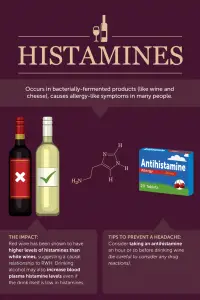
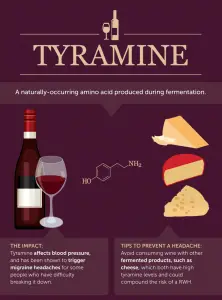
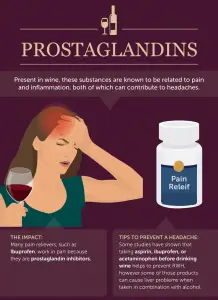
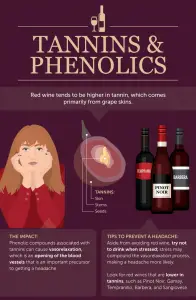
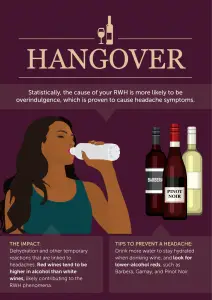

Leave a Reply